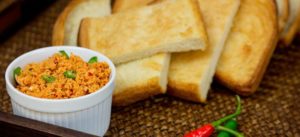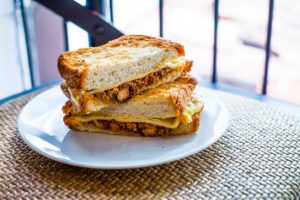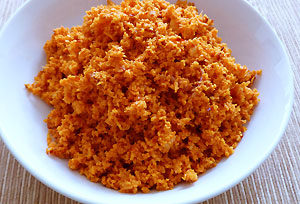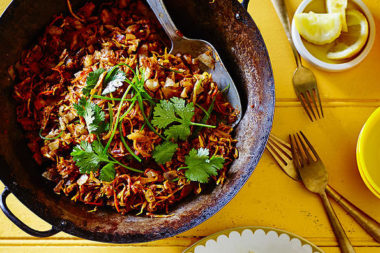Written by S Shiva (Sri Lankan Reporter)
Roast Paan with Pol Sambol
Sri Lanka has several traditional meals that every Sri Lankan just loves. They form an essential part of the country’s culinary landscape, and shape the tastes of the region. Hence we decided to give you a weekly dose of a tasty meal straight from the little South Asian island paradise that makes so many travelers fall in love with it. This week we bring you one of the top Sri Lankan breakfast / dinner essentials: Roast Paan with Pol Sambol.
Roast Paan (Roast Bread), or Double Toasted Bread as it is sometimes called, is a small flattened fresh loaf with an extra-crunchy exterior. The insides are white, soft and fragrant; forming a scrumptious whole.
The bread is not usually eaten in slices, but torn into by hand and eaten with accompaniments. Or it might be sliced lengthwise and various delicious additions will be placed between the soft centers to form a crunchy sandwich. The bread can be eaten with butter, curry, sambol, sandwich accompaniments, etc.
How to make it: Making fresh Roast Paan loaves is very easy, and can be done within a couple of hours (including baking time) in your own kitchen. The ingredients are just the usual: all-purpose flour, yeast, sugar, salt and water; with the only exotic addition being coconut oil for a more Sri Lankan touch. You will also need a loaf pan or deep all-all-purpose baking dish.
1/2 kg All-Purpose Flour
3 1/2 – 4 teaspoons Yeast
6 – 8 teaspoons Sugar
1 teaspoon Salt
2 Cups of Water
4 Teaspoons Coconut Oil / Olive Oil / Butter
Method – Activate the yeast. This is done by adding the sugar and stirring in a cup of water. Then cover for 10 minutes. When the mixture has a foamy layer on top, the yeast has been activated.
Mix the flour with the salt in a bowl. Make a well in the centre of the flour and add the activated yeast mixture. Now mix well by hand or using a dough mixer / kitchen machine.
Once the dough is well mixed and holds together in a ball, knead it for a few minutes to get a smooth consistency. Then put the dough in a big bowl and cover with a damp cloth for 30 – 40 minutes.
After you uncover it at the set time, you will find that the dough has risen to double its size. Separate 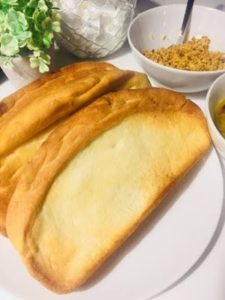 the dough into 8-9 palm sized balls. Knead them slightly separately, to make them nice and smooth, and put them aside.
the dough into 8-9 palm sized balls. Knead them slightly separately, to make them nice and smooth, and put them aside.
Take your baking pan and spray the sides with cooking spray or apply coconut oil / butter. Line with parchment paper or oil paper. Keep some rectangles of the same paper, cut into a height slightly bigger than your pan, ready
Pat all your dough balls into a sort of rectangular half moon shape about a centimeter thick, as wide as your loaf pan and slightly shorter than the pan.
Place a sheet of the prepared and cut parchment / oil paper at the end of the pan before placing the dough loaf crust upwards. Place another piece of the paper on the side of the loaf to separate it, before placing another loaf next to it. Continue stacking all your loafs. When complete, the stack should fill around three quarters of your loaf pan. Cover the pan with a damp cloth and let the loaves rise for 20 minutes, while you preheat your oven at 180°C / around 350°F.
Uncover your loaves after the set time, and you will find they have risen to fill the pan. Once the oven is preheated, drizzle /brush more coconut oil on top of the loaves (on the crust end) and place them in the oven. Bake them for 30 minutes at 180°C / 350°F.
When the top crust of the bread becomes crisp and brown, take the loaves out of the oven and separate them. You will find that the sides are only partially cooked. So place them on their semi-cooked sides on a tray or wide shallow baking pan and put them back in. You may have to use two tray for this. Bake them once again at 160°C / 320°F for 10 minutes. Remove from the oven and enjoy.
Pol Sambol
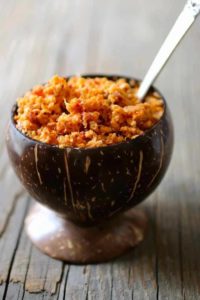 Pol Sambol’ means ‘Pounded Coconut’ in English. And that is literally how Pol Sambol is made. This accompaniment is quite spicy and eaten with all sorts of South Asian carbohydrate food such as bread, flatbread, hoppers, rotti, string hoppers, and sometimes even with rice. You can make this symbol vegan or non-vegetarian. You will need a mortar and pestle, preferably a stone one. Here’s how you do it.
Pol Sambol’ means ‘Pounded Coconut’ in English. And that is literally how Pol Sambol is made. This accompaniment is quite spicy and eaten with all sorts of South Asian carbohydrate food such as bread, flatbread, hoppers, rotti, string hoppers, and sometimes even with rice. You can make this symbol vegan or non-vegetarian. You will need a mortar and pestle, preferably a stone one. Here’s how you do it.
How to make it:
Ingredients –
Freshly scraped coconut – 1 bowl /around half a coconut
Dried Chillie Flakes / Crushed Red Chillie Pepper – 2 Tablespoons
Sliced Onions – 1 large onion
Salt – 1/2 teaspoon
Lime juice – 1 Tablespoon
Maldive Fish Chips (dried tuna flakes) – 1 Tablespoon (optional)
Method – Add the chili flakes and salt into the mortar and pound into a fine paste.
Add the Maldive fish, if you are using it, to the past and pound it until it mixes well with the paste.
Add in the coconut, mix well with the pound mixture, and pound some more for about 2 minutes (quite a bit of pounding throughout as you can see). This will release the coconut milk in the scraped coconut, adding to the flavor.
Add in the onions and pound lightly.
Finally remove the mixture from a mortar and put in a dish. Mix in the tomato (if using) and the lime juice. Then it’s ready to eat.
TIME TO SERVE!
Serve yourself a loaf of the fresh Roast Paan and and some Pol Sambol. It’s time for your Sri Lankan snack or breakfast. Tear off a bite-sized piece of freshly baked bread, add some pol sambol, holding it together with your thumb – shove it in your mouth in the typically Sri Lankan tradition. Though extremely delicious, be warned that it’s spicy. If you find it too spicy, lessen the amount of chilli in your sambol next time.
Enjoy!

